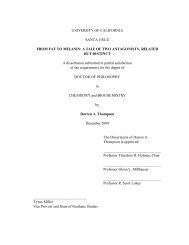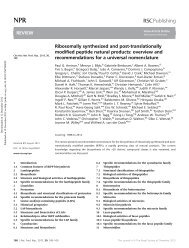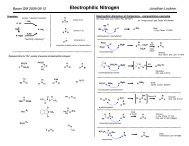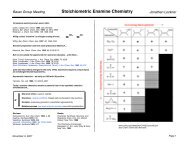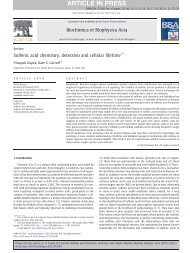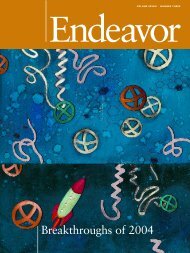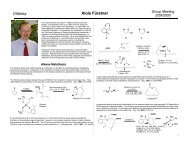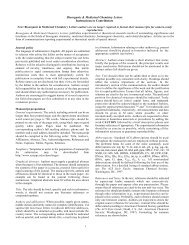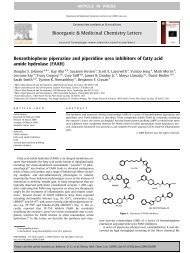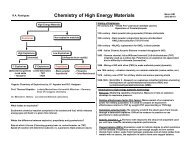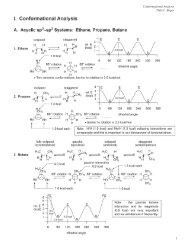The biosynthetic gene cluster for the antitumor drug bleomycin from ...
The biosynthetic gene cluster for the antitumor drug bleomycin from ...
The biosynthetic gene cluster for the antitumor drug bleomycin from ...
You also want an ePaper? Increase the reach of your titles
YUMPU automatically turns print PDFs into web optimized ePapers that Google loves.
634 Chemistry & Biology 2000, Vol 7 No 8<br />
Figure 7. A linear model <strong>for</strong> <strong>the</strong> BLM megasyn<strong>the</strong>tase-templated assembly of <strong>the</strong> BLM peptide/polyketide/peptide aglycone <strong>from</strong> nine<br />
amino acids and one acetate. Arrows with broken line indicate where <strong>biosyn<strong>the</strong>tic</strong> intermediates were derailed. Three-letter amino acid<br />
designations were used. NRPS and PKS domains are abbreviated as follows: A, adenylation; ACP, acyl carrier protein; AL, acyl CoA<br />
ligase; AT, acyltransferase; C and CP, condensation; Cy, condensation/cyclization; KR, ketoreductase; KS, ketoacyl synthase; MT,<br />
methyltransferase; Ox, oxidation; PCP, peptidyl carrier protein.<br />
modules agree with <strong>the</strong> structure of <strong>the</strong> BLM peptide^<br />
polyketide backbone. (3) <strong>The</strong> amino acid speci¢cities of<br />
two NRPS modules were con¢rmed biochemically in vitro,<br />
and <strong>the</strong> domain organization of <strong>the</strong> BlmIII and BlmIV<br />
proteins, including <strong>the</strong> unusual Cy and Ox domains, concurs<br />
with <strong>the</strong> unique bithiazole moiety of BLMs. (4) <strong>The</strong><br />
¢ve identi¢ed sugar biosyn<strong>the</strong>sis <strong>gene</strong>s, with <strong>the</strong>ir deduced<br />
functions, correspond to <strong>the</strong> sugar moiety of<br />
BLMs. (5) Fermentation of an S. lividans strain expressing<br />
a part of <strong>the</strong> cloned <strong>gene</strong> <strong>cluster</strong> in <strong>the</strong> presence of exogenously<br />
added BLM aglycones resulted in <strong>the</strong> production<br />
of BLMs.<br />
Most of <strong>the</strong> bacterial NRPS <strong>gene</strong> <strong>cluster</strong>s characterized to<br />
date are organized in operon-type structures, encoding<br />
multimodular NRPS proteins with individual modules organized<br />
along <strong>the</strong> chromosome in a linear order that parallels<br />
<strong>the</strong> order of <strong>the</strong> amino acids in <strong>the</strong> resultant peptides,<br />
i.e., following <strong>the</strong> `colinearity rule' <strong>for</strong> <strong>the</strong> NRPS-templated<br />
assembly of peptides <strong>from</strong> amino acids [1^5]. Inspection<br />
of <strong>the</strong> blm <strong>gene</strong> <strong>cluster</strong> (Figure 2B) showed that<br />
<strong>the</strong> Blm NRPS and PKS modules apparently are not organized<br />
according to <strong>the</strong> `colinearity rule' <strong>for</strong> BLM biosyn<strong>the</strong>sis<br />
(Figure 1B) (Exception to <strong>the</strong> `colinearity rule' was<br />
also noted <strong>for</strong> <strong>the</strong> syringomycin syn<strong>the</strong>tase <strong>from</strong> Pseudomonas<br />
syringae [78] and <strong>for</strong> <strong>the</strong> exochelin syn<strong>the</strong>tase <strong>from</strong><br />
M. smegmatis [75]. In fact, Grandi and co-workers have demonstrated<br />
recently in B. subtilis that nei<strong>the</strong>r <strong>the</strong> operon-type<br />
structure nor <strong>the</strong> physical linkage of individual modules is<br />
essential <strong>for</strong> proper assembly and activity of <strong>the</strong> surfactin<br />
NRPS megasyn<strong>the</strong>tase [79].) Realizing that <strong>the</strong> BLM biosyn<strong>the</strong>sis<br />
cannot be rationalized according to <strong>the</strong> `colinearity<br />
rule', we predicted <strong>the</strong> substrate speci¢cities of individual<br />
NRPS modules according to <strong>the</strong> speci¢city conferring<br />
codes <strong>for</strong> A domains [18] and deduced <strong>the</strong> extender unit of<br />
<strong>the</strong> PKS module according to <strong>the</strong> signature motifs of <strong>the</strong><br />
AT domain [50]. Using <strong>the</strong> substrate speci¢city of individual<br />
NRPS and PKS modules as a guide, we were able to<br />
align <strong>the</strong> nine NRPS and one PKS modules to constitute<br />
<strong>the</strong> Blm megasyn<strong>the</strong>tase (Figure 7) according to our hybrid<br />
NRPS^PKS^NRPS model <strong>for</strong> BLM biosyn<strong>the</strong>sis (Figure<br />
1B). Although its overall structure resembles that of known<br />
NRPSs and PKSs, <strong>the</strong> Blm megasyn<strong>the</strong>tase exhibits several<br />
novel features. <strong>The</strong> latter is in fact expected since <strong>the</strong><br />
BLM backbone contains several unusual structural features,<br />
such as <strong>the</strong> L-aminoalaninamide and <strong>the</strong> pyridimidine<br />
moieties, both of which are unprecedented in peptide<br />
biosyn<strong>the</strong>sis.<br />
On <strong>the</strong> basis of <strong>the</strong> BLM structure and <strong>the</strong> deduced functions<br />
of individual NRPS and PKS domains, we propose<br />
<strong>the</strong> following model <strong>for</strong> <strong>the</strong> Blm megasyn<strong>the</strong>tase-templated<br />
syn<strong>the</strong>sis of BLMs. <strong>The</strong> individual modules are ¢rst<br />
primed with amino acid or carboxylic acid precursors, <strong>the</strong><br />
substrate speci¢cities of which are determined by <strong>the</strong> A<br />
domains of <strong>the</strong> NRPS or <strong>the</strong> AT domain of PKS modules,<br />
respectively (Figure 7). We propose that <strong>the</strong> NRPS-4-activated<br />
Ser is fur<strong>the</strong>r dehydrated into dehydroalanine (Dha)<br />
be<strong>for</strong>e its incorporation into <strong>the</strong> peptide product. Although<br />
dehydroamino acids, such as Dha, are enamines and are<br />
unlikely to be suf¢ciently stable, <strong>the</strong>ir stability could be<br />
improved when <strong>the</strong>y are linked covalently, via a thioester<br />
bond, to <strong>the</strong> PCP domains and hence are sequestered by<br />
<strong>the</strong> protein. Dha or dehydrothreonine (Dht), also known as<br />
2,3-dehydroaminobutyric acid, are present in many peptides,<br />
such as thiostrepton [83], microcystin [76], and syringomycin<br />
[78]. Although it is yet to be determined if <strong>the</strong><br />
dehydration requires an additional enzyme, sequence analyses<br />
of both <strong>the</strong> NRPS-4 module and <strong>the</strong> NRPS modules<br />
<strong>for</strong> Dha in <strong>the</strong> microcystin <strong>cluster</strong> [76] and <strong>for</strong> Dht in <strong>the</strong>



